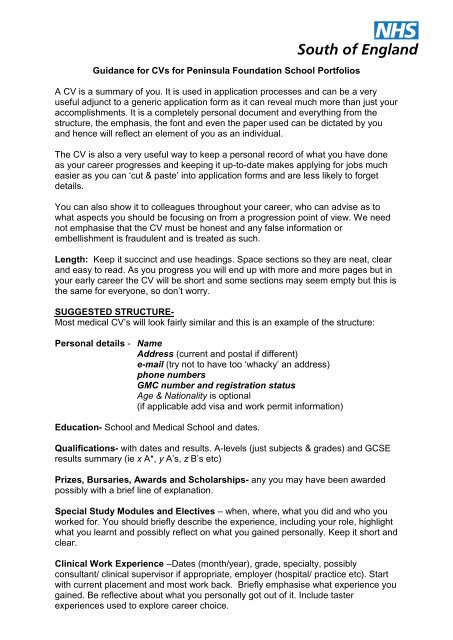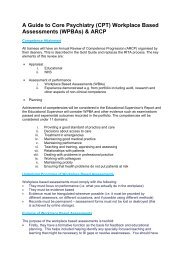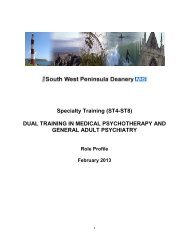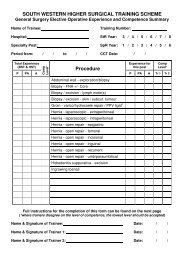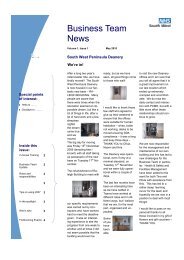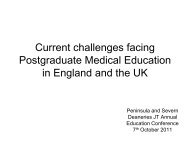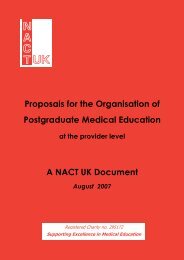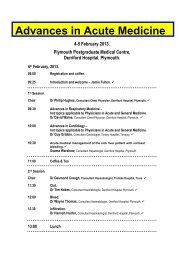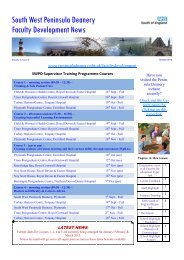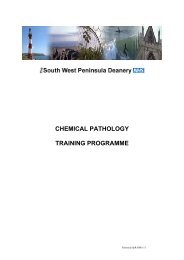CV template for sign off
CV template for sign off
CV template for sign off
You also want an ePaper? Increase the reach of your titles
YUMPU automatically turns print PDFs into web optimized ePapers that Google loves.
Guidance <strong>for</strong> <strong>CV</strong>s <strong>for</strong> Peninsula Foundation School Portfolios<br />
A <strong>CV</strong> is a summary of you. It is used in application processes and can be a very<br />
useful adjunct to a generic application <strong>for</strong>m as it can reveal much more than just your<br />
accomplishments. It is a completely personal document and everything from the<br />
structure, the emphasis, the font and even the paper used can be dictated by you<br />
and hence will reflect an element of you as an individual.<br />
The <strong>CV</strong> is also a very useful way to keep a personal record of what you have done<br />
as your career progresses and keeping it up-to-date makes applying <strong>for</strong> jobs much<br />
easier as you can ‘cut & paste’ into application <strong>for</strong>ms and are less likely to <strong>for</strong>get<br />
details.<br />
You can also show it to colleagues throughout your career, who can advise as to<br />
what aspects you should be focusing on from a progression point of view. We need<br />
not emphasise that the <strong>CV</strong> must be honest and any false in<strong>for</strong>mation or<br />
embellishment is fraudulent and is treated as such.<br />
Length: Keep it succinct and use headings. Space sections so they are neat, clear<br />
and easy to read. As you progress you will end up with more and more pages but in<br />
your early career the <strong>CV</strong> will be short and some sections may seem empty but this is<br />
the same <strong>for</strong> everyone, so don’t worry.<br />
SUGGESTED STRUCTURE-<br />
Most medical <strong>CV</strong>’s will look fairly similar and this is an example of the structure:<br />
Personal details - Name<br />
Address (current and postal if different)<br />
e-mail (try not to have too ‘whacky’ an address)<br />
phone numbers<br />
GMC number and registration status<br />
Age & Nationality is optional<br />
(if applicable add visa and work permit in<strong>for</strong>mation)<br />
Education- School and Medical School and dates.<br />
Qualifications- with dates and results. A-levels (just subjects & grades) and GCSE<br />
results summary (ie x A*, y A’s, z B’s etc)<br />
Prizes, Bursaries, Awards and Scholarships- any you may have been awarded<br />
possibly with a brief line of explanation.<br />
Special Study Modules and Electives – when, where, what you did and who you<br />
worked <strong>for</strong>. You should briefly describe the experience, including your role, highlight<br />
what you learnt and possibly reflect on what you gained personally. Keep it short and<br />
clear.<br />
Clinical Work Experience –Dates (month/year), grade, specialty, possibly<br />
consultant/ clinical supervisor if appropriate, employer (hospital/ practice etc). Start<br />
with current placement and most work back. Briefly emphasise what experience you<br />
gained. Be reflective about what you personally got out of it. Include taster<br />
experiences used to explore career choice.
This section could sound very similar to other candidates so as you progress you will<br />
tend not to include your medical student experiences.<br />
Non-clinical Work Experience – Include dates, company name, your role and<br />
some in<strong>for</strong>mation about what you did there. Highlight the transferable skills, how you<br />
contributed to the role and what experience you gained.<br />
Volunteering – You can arrange the in<strong>for</strong>mation in a distinct section, or incorporate<br />
it into your work experience section as long as you clearly show it as a voluntary<br />
activity and show the transferable skills.<br />
Interests, Responsibilities and Achievements– everyone arranges these<br />
differently depending on what they have done. They show a lot about you as an<br />
individual and always be thinking about potential transferable skills.Your interests<br />
are important as they show what you like to do, how you have contributed outside of<br />
work/study, and how you have developed yourself. Try not just list your interests but<br />
put them into a meaningful context and explain the extent to which you participate.<br />
This often can <strong>for</strong>m an ‘ice-breaker’ first question at interview. Responsibilities can<br />
include roles within clubs and societies - treat them like a job role and show the skills<br />
you have used and gained. Your achievements may overlap with either of the<br />
above. Again, provide some in<strong>for</strong>mation about the work you put in, what you got out<br />
of it, and how it has helped you develop. This is where everyone differs and<br />
remember…. you will get found out if you are less than truthful. If you don’t love 16 th<br />
century Danish poetry or weren’t treasurer of the tiddlywinks club don’t put it down as<br />
your interviewer is bound to be a Danish tiddlywinks champion!!<br />
Additional Skills – such as IT and languages. Name the packages and/or<br />
languages and indicate your level of proficiency.<br />
Courses- <strong>for</strong>mal educational courses/ meetings attended: title, date, educational<br />
body, venue and possibly brief summary of what you learnt.<br />
Teaching- brief details of:<br />
a) relevant <strong>for</strong>mal (non medical school) teaching you have attended (eg F1 teaching<br />
programme)<br />
b) any teaching you have delivered (date, title, audience: students/nurses etc, ?as<br />
part of a <strong>for</strong>mal teaching programme)<br />
Audit- title, date, department, ?first cycle/re-audit, brief explanation including<br />
changes suggested/ effect on practice. Aim <strong>for</strong> at least one audit a year as a doctor.<br />
Publications & Research- a box you need to start filling <strong>for</strong> some of the more<br />
competitive specialities. Quote any publications by the full journal reference and give<br />
short explanations.<br />
Presentations- title, meeting presented at, venue, date & short explanation.<br />
Career Aim –Short and purposeful, demonstrating your direction.<br />
References – usually two referees are required <strong>for</strong> specialty application. Check that<br />
they are happy to act as a referee <strong>for</strong> you and provide their name, job title, work<br />
address, phone (?secretary direct line) and an e-mail address <strong>for</strong> easy contact.


